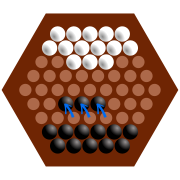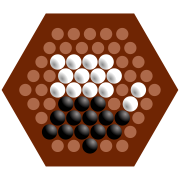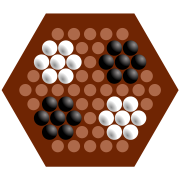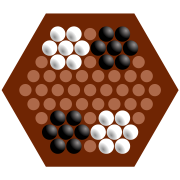.gif)
Abalone (board game)
Encyclopedia
Abalone is an award winning two-player strategy board game
designed by Michel Lalet and Laurent Levi in which each player is represented by marbles of opposing colors. The objective is to push six of the opponent's marbles off the edge of the board.


 The board consists of 61 circular spaces arranged in a hexagon, five on a side.
The board consists of 61 circular spaces arranged in a hexagon, five on a side.
Each player has 14 marbles that rest in the spaces and are initially arranged as shown at left.
Play alternates between the players one move at a time, with the black marbles moving first. For each move, a player moves a line of one, two or three one space. The move can be either in-line (parallel to the line of marbles) or broadside (not parallel to the line of marbles), as illustrated at right.
A player can push their opponent′s marbles which are in an adjacent space to their own with an in-line move only. They can only push if the pushing line has more marbles than the pushed line (three can push two or one; two can push one). Marbles must be pushed into an open space (i.e. not blocked by a marble of either colour). The winner is the first player to push six of the opponent's marbles off of the edge of the board.
I O O O O O
H O O O O O O
G + + O O O + +
F + + + + + + + +
E + + + + + + + + +
D + + + + + + + + 9
C + + @ @ @ + + 8
B @ @ @ @ @ @ 7
A @ @ @ @ @ 6
1 2 3 4 5
A popular notation:
An inline move can be denoted by the movement of the trailing marble.
Broadside moves can be denoted by the initial positions of the two extremities of the row followed by the final position of the first one (thus, with this notation, each broadside move has two notations possible, which could be avoided).
 The dynamics of the basic game may have one serious flaw: it seems that a good, conservative player can set up his or her marbles in a defensive wedge, and ward off all attacks indefinitely. An attacker may try to outflank this wedge, or lure it into traps, but such advances are often more dangerous to the attacker than the defender. Thus, from the starting position, it takes little skill and no imagination to avoid losing, and nothing in the rules prevents games from being interminable.
The dynamics of the basic game may have one serious flaw: it seems that a good, conservative player can set up his or her marbles in a defensive wedge, and ward off all attacks indefinitely. An attacker may try to outflank this wedge, or lure it into traps, but such advances are often more dangerous to the attacker than the defender. Thus, from the starting position, it takes little skill and no imagination to avoid losing, and nothing in the rules prevents games from being interminable.
Because it is boring for games to be drawn out indefinitely, serious Abalone players tacitly agree to play aggressively. A player who forms a defensive wedge and makes no attempt to attack is therefore likely to be a novice who might lose anyway. Nevertheless, the possibility of any competent player bringing the game to a standstill, and successfully avoiding losing to even a championship-calibre player, remains troubling.
There are several possible solutions to this conundrum. First, in tournaments, a judge may penalize a player for playing defensively. This solution is somewhat unsatisfactory, given that a judge may not always be present, and that "defensive play" is a subjective notion.
Second, several variations of the rules of play have been developed for the same board and marbles. None of the variations has the same appealing simplicity of the original.

 The third, and perhaps best, alternative starting positions have been designed to make the formation of stalemate wedges less likely. Experiments are still underway to find an opening position, which neither devolves into a draw nor gives too great an advantage to the first player. One popular attempt is the Marguerite (daisy) positions, two versions of which are displayed on the left and on the right.
The third, and perhaps best, alternative starting positions have been designed to make the formation of stalemate wedges less likely. Experiments are still underway to find an opening position, which neither devolves into a draw nor gives too great an advantage to the first player. One popular attempt is the Marguerite (daisy) positions, two versions of which are displayed on the left and on the right.
A number of two-player variations use a third colour for passive pieces, for example variation The Pillar (with a fixed marble in the centre of the board), which has been examined to some depth by Alex Borello and Nicolas Le Gal. Another possible variation involves either player winning the game if he ejects the central marble. A few variations use a second layer of marbles.
Gert Schnider and Thomas Fenner participated in the evaluation and adjustment of Aba-Pro. Marc Tastet was the 1992 World Othello
Champion, Stephane Nicolet is a two-time World Othello
Championship finalist, and Jan Stastna is a strong Othello
player.
Board game
A board game is a game which involves counters or pieces being moved on a pre-marked surface or "board", according to a set of rules. Games may be based on pure strategy, chance or a mixture of the two, and usually have a goal which a player aims to achieve...
designed by Michel Lalet and Laurent Levi in which each player is represented by marbles of opposing colors. The objective is to push six of the opponent's marbles off the edge of the board.
Rules



Each player has 14 marbles that rest in the spaces and are initially arranged as shown at left.
Play alternates between the players one move at a time, with the black marbles moving first. For each move, a player moves a line of one, two or three one space. The move can be either in-line (parallel to the line of marbles) or broadside (not parallel to the line of marbles), as illustrated at right.
A player can push their opponent′s marbles which are in an adjacent space to their own with an in-line move only. They can only push if the pushing line has more marbles than the pushed line (three can push two or one; two can push one). Marbles must be pushed into an open space (i.e. not blocked by a marble of either colour). The winner is the first player to push six of the opponent's marbles off of the edge of the board.
Move notation
The notation for recording moves gives the letters A-I to the horizontal lines, and the numbers 1-9 to northwest-southeast diagonals.I O O O O O
H O O O O O O
G + + O O O + +
F + + + + + + + +
E + + + + + + + + +
D + + + + + + + + 9
C + + @ @ @ + + 8
B @ @ @ @ @ @ 7
A @ @ @ @ @ 6
1 2 3 4 5
A popular notation:
An inline move can be denoted by the movement of the trailing marble.
Broadside moves can be denoted by the initial positions of the two extremities of the row followed by the final position of the first one (thus, with this notation, each broadside move has two notations possible, which could be avoided).
Avoiding draws

Because it is boring for games to be drawn out indefinitely, serious Abalone players tacitly agree to play aggressively. A player who forms a defensive wedge and makes no attempt to attack is therefore likely to be a novice who might lose anyway. Nevertheless, the possibility of any competent player bringing the game to a standstill, and successfully avoiding losing to even a championship-calibre player, remains troubling.
There are several possible solutions to this conundrum. First, in tournaments, a judge may penalize a player for playing defensively. This solution is somewhat unsatisfactory, given that a judge may not always be present, and that "defensive play" is a subjective notion.
Second, several variations of the rules of play have been developed for the same board and marbles. None of the variations has the same appealing simplicity of the original.


Rule variations
Abalone can be played by three people (or more) using the same board with fewer marbles, each in three different colours.A number of two-player variations use a third colour for passive pieces, for example variation The Pillar (with a fixed marble in the centre of the board), which has been examined to some depth by Alex Borello and Nicolas Le Gal. Another possible variation involves either player winning the game if he ejects the central marble. A few variations use a second layer of marbles.
Strategy
Forums of Abalone communities have found that generally:- Keep the marbles close to the centre of the board and force the opponent to move to the edges
- Keep the marbles close together for increased defense and attack, especially in a hexagon shape to be able to push or defend in any direction
- Pushing the opponent off the board is not usually a good idea if it leads to weaknesses in the player’s geometry
Origins
Abalone was invented in 1987 by Laurent Levi and Michel Lalet. In 1999, a number of top players from the Mind Sport Olympic signed an agreement to use a different starting position (the Belgian daisy) to revitalize the game. This has been used for top tournaments since then, including the AbaCup.Champions
No official world championships have been held; the only international tournament is the Mind Sports Olympiad.- 1997:
 Marc Tastet (France)
Marc Tastet (France) - 1998:
 Vojtěch Hrabal (Czech Republic)
Vojtěch Hrabal (Czech Republic) - 1999:
 Gert SchniderGert SchniderGert Schnider is an Austrian professional multi-talented board-game player, e.g. of Chess , Go and Shogi and an Abalone grandmaster....
Gert SchniderGert SchniderGert Schnider is an Austrian professional multi-talented board-game player, e.g. of Chess , Go and Shogi and an Abalone grandmaster....
(Austria) - 2000:
 Gert SchniderGert SchniderGert Schnider is an Austrian professional multi-talented board-game player, e.g. of Chess , Go and Shogi and an Abalone grandmaster....
Gert SchniderGert SchniderGert Schnider is an Austrian professional multi-talented board-game player, e.g. of Chess , Go and Shogi and an Abalone grandmaster....
(Austria) - 2001:
 Thomas Fenner (Germany)
Thomas Fenner (Germany) - 2002:
 Jan Šťastna (Czech Republic)
Jan Šťastna (Czech Republic) - 2003:
 Stephane Nicolet (France)
Stephane Nicolet (France) - 2004:
 Alex Borello (France)
Alex Borello (France) - 2005:
 David M. Pearce (United Kingdom)
David M. Pearce (United Kingdom) - 2006:
 Jan Šťastna (Czech Republic)
Jan Šťastna (Czech Republic) - 2007:
 Vincent Frochot (France)
Vincent Frochot (France) - 2008:
 Jan Šťastna (Czech Republic)
Jan Šťastna (Czech Republic) - 2009:
 David M. Pearce (United Kingdom)
David M. Pearce (United Kingdom) - 2010:
 Vincent Frochot (France)
Vincent Frochot (France) - 2011:
 Vincent Frochot (France)
Vincent Frochot (France)
Gert Schnider and Thomas Fenner participated in the evaluation and adjustment of Aba-Pro. Marc Tastet was the 1992 World Othello
Reversi
Reversi is a board game involving abstract strategy and played by two players on a board with 8 rows and 8 columns and a set of distinct pieces for each side. Pieces typically are disks with a light and a dark face, each face belonging to one player...
Champion, Stephane Nicolet is a two-time World Othello
Reversi
Reversi is a board game involving abstract strategy and played by two players on a board with 8 rows and 8 columns and a set of distinct pieces for each side. Pieces typically are disks with a light and a dark face, each face belonging to one player...
Championship finalist, and Jan Stastna is a strong Othello
Reversi
Reversi is a board game involving abstract strategy and played by two players on a board with 8 rows and 8 columns and a set of distinct pieces for each side. Pieces typically are disks with a light and a dark face, each face belonging to one player...
player.
External links
- Aba-Pro probably strongest Abalone program which won ICGA tournament in Graz 2003
- ICGA Tournaments - list of games

